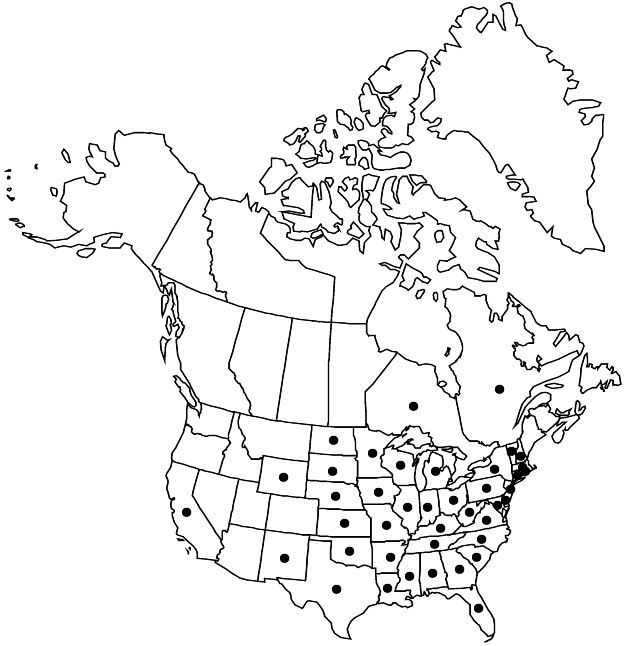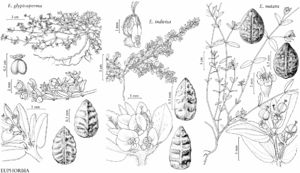Euphorbia nutans
Gen. Sp. Pl., 17. 1816.
Herbs, annual, with taproot. Stems usually ascending, occasionally erect, often arched at tips, 20–80 cm, sparsely to moderately pilose to villous or with short, incurved hairs, hairs often concentrated at nodes and distally, occasionally in 2 bands along opposite sides of stem. Leaves opposite; stipules usually distinct, sometimes connate basally on one side of stem, small scales, irregularly toothed, fringed, or divided, 1–1.5 mm, sparsely to moderately villous distally; petiole 0.3–1.6 mm, moderately pilose to villous; blade oblong to oblong-lanceolate, 8–40 × 3–12 mm, base asymmetric, one side usually angled or rounded, other side ± truncate to cordate-auriculate, margins serrulate, apex angled with blunt tip, abaxial surface pale green or faintly to strongly reddish tinged, adaxial surface usually reddish-mottled or with conspicuous reddish spot, both surfaces usually sparsely to moderately pilose, especially toward base, sometimes glabrous; 3–5-veined from base, pinnate distally, veins faint. Cyathia solitary at distal nodes or in small, cymose clusters at branch tips; peduncle 0.5–2.5 mm. Involucre narrowly obconic, 0.5–1 × 0.3–0.7 mm, glabrous; glands 4, usually green, sometimes reddish purple, oblong to nearly circular, 0.2–0.4 × 0.3–0.5 mm; appendages white or pinkish, ovate to broadly elliptic, 0.2–1 × 0.2–1.5 mm, distal margin entire. Staminate flowers 5–28. Pistillate flowers: ovary glabrous; styles 0.6–2.5 mm, 2-fid 1/2 length. Capsules ovoid, 1.6–2.3 × 1.5–2.4 mm, glabrous; columella 1.4–1.6 mm. Seeds dark brown, sometimes with thin, white coating (often more persistent along angles than faces), elliptic-ovoid to ovoid, rounded-angular in cross section, 1–1.6 × 0.5–0.8 mm, surface finely and irregularly wrinkled, sometimes faintly so, or with indistinct, shallow, rounded cross ridges. 2n = 12, 14, 22.
Phenology: Flowering and fruiting spring–early fall.
Habitat: Stream banks, pond edges, disturbed portions of upland prairies, mesic to dry upland forest openings, pastures, fallow fields, railroads, roadsides, gardens, disturbed areas.
Elevation: 0–1600 m.
Distribution

Ont., Que., Ala., Ark., Calif., Conn., Del., Fla., Ga., Ill., Ind., Iowa, Kans., Ky., La., Md., Mass., Mich., Minn., Miss., Mo., Nebr., N.H., N.J., N.Mex., N.Y., N.C., N.Dak., Ohio, Okla., Pa., R.I., S.C., S.Dak., Tenn., Tex., Vt., Va., W.Va., Wis., Wyo., Mexico, West Indies, Central America, South America, introduced in Eurasia.
Discussion
Euphorbia nutans is probably native to at least central and eastern North America, but given its strongly weedy tendencies, it is difficult to know where it may be adventive in parts of the flora area. It is certainly introduced where it occurs in the Old World and probably in South America as well. D. G. Burch (1966) discussed the problems of assigning names to the four main entities in this nomenclatural complex (E. hypericifolia, E. hyssopifolia, E. lasiocarpa, and E. nutans) and determined that the oldest valid name for the relatively robust, temperate North American plants with ascending stems is E. nutans. See the treatment of 56. E. maculata for a discussion of the misapplication of that name to E. nutans.
Selected References
None.
